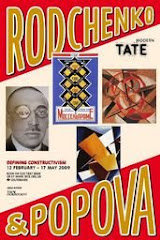Myth presentation-- Rodchenko and Popova, Russia constructivism and the state
** Slide 1- title page**
The Russia revolution of 1917 saw the overthrow of the tsarist autocracy in February of that year, with the Bolsheviks eventually managing to seize power in the October. The Bolsheviks proceeded to establish the world’s first communist state. This event is regarded by many as one of the most consequential events of the twentieth century, proving, as it did, an inspiration for revolutions in other countries such as China, as well as influencing, or provoking, the rise of Fascism in Europe and, after 1945, providing the foil against which the West defined itself, as well as, along with the West, drawing, or re-drawing the architecture of foreign policy and international relations and interventions.
The conception of progress conceived the Bolsheviks was greatly indebted to Enlightenment ideals, reflected in their belief that the dissemination of knowledge and rationality would liberate people from their superstitious and backward ways, and lead to an enhanced freedom and autonomy. They aimed to do this by raising the level of 'culturedness' of Russian society, which at the time was conceived as being steeped in 'Asiatic' backwardness. By 1921, once they had gained victory on both the political and military fronts, culture was declared the 'third front' of the revolution, or revolutionary activity. This development of 'culturedness' included carrying out ones trade union duties efficiently, punctuality and cleanliness, and literacy. Lenin proposed the concept of 'cultural revolution' as a vital stage in the development of the country towards socialism, within the framework of Marx's historical determinism.
Other Bolsheviks, such as Bukharin, promoted a more radical conception of what Cultural Revolution could and should be. He asserted that it should be a: 'revolution in human characteristics, in habits, in feelings, and desires, in way of life and culture'. As such, his aim was the creation of a 'new soviet person' through a total transformation of daily life.
** Slide 2 **
The art movement known as 'constructivism' accompanied the Russian revolution, with the first use of the term being a reference to the work of Alexander Rodchenko. The movement aimed to question the fundamental properties of what art is, what art can be, and what its place should be within the new kind of society they saw emerge. The ideological concept behind the movement was to produce art forms that could contribute to everyday life. This conception mirrors that of Bukharin, whereby art, in the form of painting, architecture, design, film, as well as every-day objects, could be used to advance the revolution, and ultimately transform the every-day life of the people, creating a new culture, and eventually the 'new soviet person' conceived by Bukharin.
In the early years after the revolution, artists sought to re-invent art starting from zero. This involved the rejection of ideas of illusory representation, limiting the paintings of Rodchenko as well as Popova to geometrical patterns, with an emphasis on the relationship between textures and colours. This reflects their conception of the artist as engineer, and the production of the art object as not dissimilar to that of any other manufacturing process, which as such, was seen as in keeping with the ideals of the revolution by casting the artist as a worker like any other. In May 1920, the research institute and think-tank INKhUK was founded as a forum for the discussion of the principles that should underline modern art.
Ultimately it was decided that the medium of painting was irreconcilable both with their approach and aesthetic, as well as with their ideology. Their final exhibition, 5 x 5 = 25, which opened in September 1921 was their farewell, the works exhibited included a piece by Popova constructed of straight lines and triangles, as well as Redshank’s famous triptych of three canvases in each of the primary colours, affirming that 'every plane is a plane and there is to be no representation'.
With the advent of Lenin's New Economic Policy, or NEP, which allowed private enterprise to operate on a limited scale, the constructivists were employed to create the advertising for state run industries facing new competition; they were also involved in the production of posters for propaganda and education, including histories of the Bolshevik party. Here we can see the increasing role played by the artist in narrating a history and society, based on the Marxist determinist model of progress, about and for the newly enfranchised poor and uneducated masses.
** Slide 3 **
With the ultimate goal being the creation of a new cultural paradigm for the new kind of individual, with the cultural revolution involving revolutions in the forms of desires, feelings and ways of life, both Popova and Rodchenko moved into the implementation of this cultural revolution by changing the conditions of every-day life, these included in particular, fabric designs and costume designs by Popova, as well as cigarette packets and utilitarian clothes by Rodchenko. This move to designing everyday objects reflects the Marxist conception of the base structure, in the form of the conditions of everyday life, is reflected in the superstructure, which includes politics and ideology, and as such was a core tool for the construction and narration of the myth of Marx's determinist model of historical progress.
Points of debate:
The contemporary use in advertising and design of constructivist inspired aesthetic; what does it mean today? A signifier of defiance and revolution? How is it used and exploited by advertising design etc. to sell products and create a narrative around the kind of person that buys and consumes these products. Tapping in to the popular imagination.
Dichotomy between revolutionary and proletariat art?
Thursday, 30 April 2009
Subscribe to:
Post Comments (Atom)

No comments:
Post a Comment